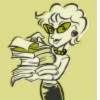 Boston, L.M. 1955. THE CHILDREN OF GREEN KNOWE. New York: Harcourt, Inc. ISBN 0-15-202468-9
Boston, L.M. 1955. THE CHILDREN OF GREEN KNOWE. New York: Harcourt, Inc. ISBN 0-15-202468-9Toseland must go to live with his great-grandmother, Mrs. Oldknow, for the winter break from school. Though they have never met, it is obvious they immediately get along and are glad to have each other. On their first encounter, Mrs. Oldknow tells Tolly, “So you’ve come back!” she said, smiling, as he came forward, and he found himself leaning against her shoulder as if he knew her quite well.” Tolly has always been a bit of a loner—especially since his mother died. With no siblings, he is eager to find playmates. His innate sense of curiosity draws him into the mysterious happenings in his grandmother’s home and she patiently and lovingly encourages his exploration and discovery. This third-person omniscient narrative fantasy is a ghost story, though not in a typical sense. Rather than the reader and characters being afraid of the ghosts, we are all eager for them to show themselves. Mrs. Oldknow encourages the ghosts’ appearance by giving Tolly some of their belongings and telling stories of when they were alive. The identities of the ghosts is one of the most enjoyable discoveries of this novel, and thus shall not be divulged here. Boston uses formal speech and narrative to tell the story of a lonely child discovering the mysteries of his family’s manor. This manor is described in incredible detail—the smells of the stable, the topiary garden, the bedrooms and living rooms, and the many animals which roam about. Though a bit slow moving, the reader cannot help but “see” the story unfold through Boston’s descriptive writing style.
This story is recommended for readers grades 3-6.

No comments:
Post a Comment